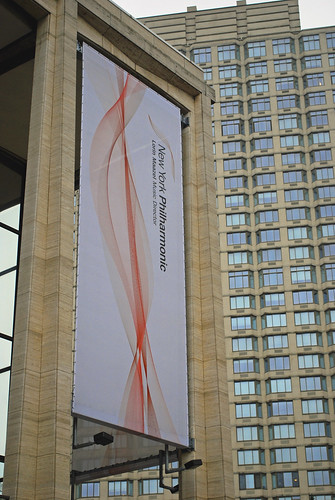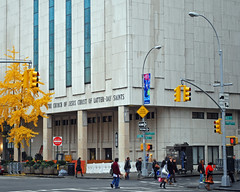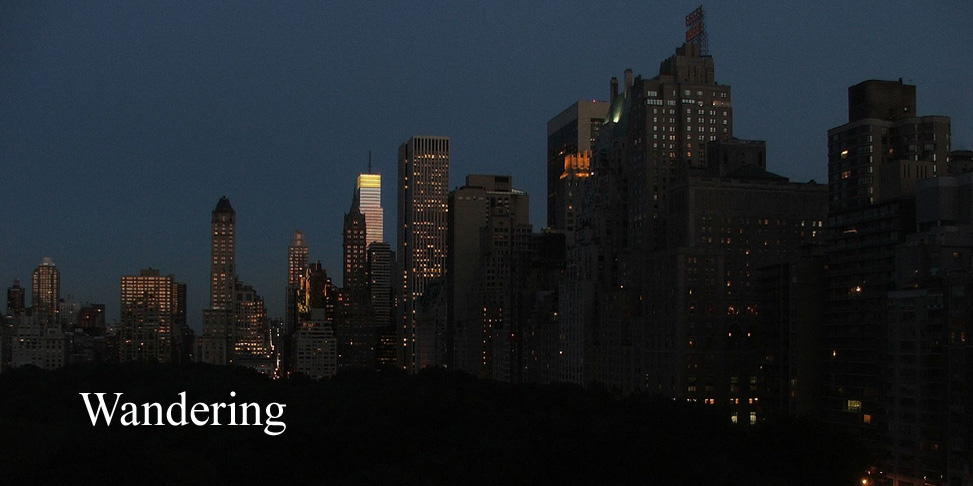
Just like in the movies the traffic on Broadway was at a standstill with horns blasting as I headed out the New York Philharmonic on Wednesday. I then saw the hold up was caused by a demonstration several thousand strong proceeding south on the other side of the street. At first, it was hard to work out what it was about. I saw various banners and signs
LOVE NOT H8
SEPERATE IS NOT EQUAL
I LOVE MY MORMON FAMILY
JESUS LOVES ME AND MY BOYFRIEND
As I walked along, it became clear the procession was a protest about the adoption of Proposition 8 in the referendum which California held on November 4. Others were as mystified as I was about why the demonstration was happening on the upper west side of New York City.
“Proposition 8 is California isn’t it – why are they here?”
“Sympathy I guess”
“Do you think so?”
And one older lady clambering into Avery Fisher Hall, clearly not into IM:
“I don’t get this aitch eight”
Unexpectedly, the clue to the thing was the Mormon sign. There is a large Mormon church opposite Avery Fisher Hall, and it has now become apparent that the Mormons poured millions of dollars into support of Proposition 8. An article in the New York Times today suggests it would not have passed without this support.

The concert was the New York Philharmonic conducted by Andrey Boreyko with Gil Shaham playing the Khachaturian violin concerto.
The concert began with a short tone poem, Kikimora, by the Russian composer Anatoly Lyadov (1855 – 1914). Hello Mr. Melody Man!: the only work of Lyadov I could think of was his A musical snuffbox used as a theme by Lindley Evans on the ABC Childrens Hour so long ago. Kikmora was a pleasant if not very memorable piece which brought Rimsky – Korsakov’s music to mind. (And Lyadov was Rimsky Korsakov’s pupil.) It was interesting to hear it in this program which ended with the 1919 version of Stravisnky’s Firebird Suite, as I realised listening to Kikmora that works like Firebird and Petrushka which struck me as unique inventions when I first heard them had very strong roots in works of this kind. In fact, the program note explains that Diaghilev was a pupil of Lyadov, and wanted him to compose the Firebird score and only turned to Stravinsky when Lyadov failed to “fish or cut bait”. Though I doubt Diaghilev put it that way.
I learn from the Wikipeida that Liadov’s pupils included Prokofiev and Nicolai Malko, another link with the distant past as Dr. Malko was chief conductor of the SSO, and I remember sitting in the organ gallery of the Sydney Town Hall watching him, deathly pale, conducting the orchestra. His appearance was not deceptive as he lived for only a short time after that concert.
Next came the violin concerto. I saw Gil Shaham play here a couple of years ago but was unprepared for this exuberant performance. He smiled broadly at the conductor and then at no one in particular. He crouched, he move around the platform between the conductor and the first violins, often approaching the conductor so closely that he appeared to be playing for him rather than the audience. From where I was seated at the left front he entirely disappeared behind the conductor at times. In the slow movement his facial expression changed to one of ecstatic reverie, .but the gawky broad smile was back for the finale.
None of this was inappropriate for the concerto, a lively work with great melodies which becomes very exciting at times, especially when the violinist is a crouching tiger.
After intermission the orchestra played Abii ne viderem for String Orchestra, Alto Flute, Piano Harpsichord and Bass Guitar by the contemporary composer Giya Kancheli who was born in Georgia but now lives in Belgium. I did not know of Kancheli, and for me this was the most interesting work in the concert. The list of solo instruments gives a false impression as the flute is the only on with a significant solo part, and that consists at times of the repetition of a single note. The program says that Kancheli is numbered amongst Eastern European composers who have explored the “new mysticism”. I remain skeptical about program music mystical or otherwise, but the piece contain a range of sounds which demonstrated that a traditional orchestra still has a great deal of life left in it. Many fascinating sounds and contrasts and a lot of silence ( maybe the mystical part ).
The concert ended with a fine performance of the 1919 version of Stravinsky’s Firebird Suite. This version was scored for a smaller string section than the ballet itself and the Philharmonic followed the score. I have found that the acoustics of Avery Fisher Hall vary from place to place, but where I was sitting the grinding deep bass from the basses which opens the work was marvelous to hear. The woodwind parts were also crystal clear and subjectively at least somewhat louder than they usually seem. This was odd, because the Philharmonic is arranged on a flat platform and from where I was in front of any raking in the seats I was unable to see the woodwind section at all.





No comments:
Post a Comment